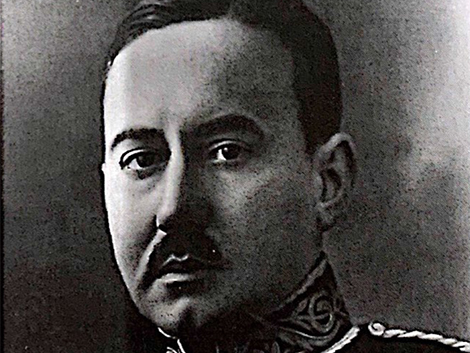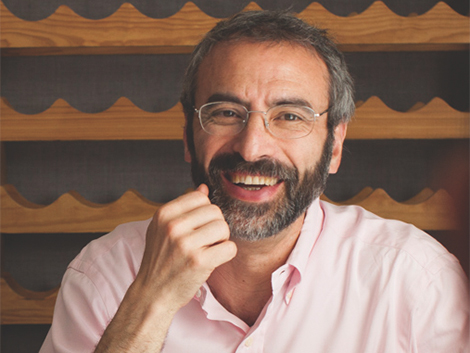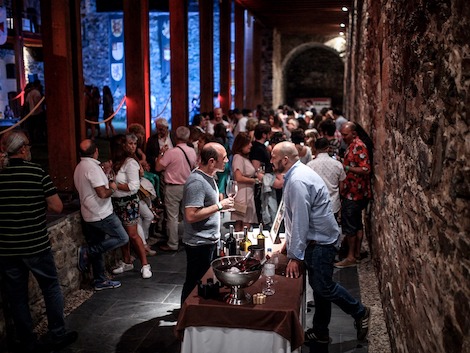
"I leave all the land I own in Sitges, as well as the other houses I own in this village and all the contents of the winery located at number 1, San Gaudencio Street, for charity purposes in Sitges". This was the will of Don Manuel Llopis de Casades (1885-1935), a lawyer and diplomat raised in one of the most prominent families of this beautiful Catalan coastal town. He died childless while serving at the Spanish consulate in Sofia.
A staunch supporter of the sweet Malvasia wines that made his hometown famous, Llopis had foreseen its disappearance for some time. The decline had been exposed in a report written by producer Lluis i Dalmau on the occasion of a Scientific-Literary symposium held in Sitges in 1886. Dalmau blamed the whims of fashion and the devastation caused by powdery mildew. As described in his report, Malvasía was at the time a challenging wine to make: unfortified and sweet, it required up to three or four different harvests in order to obtain perfectly golden grapes.
The arrival of phylloxera only added to the decline of Malvasia. By the 1980s, the expansion of tourism had wiped out almost all the vineyards in Sitges. The wines gradually lost their identity and were degraded into Mistela (a drink made by adding alcohol to unfermented grape must). The efforts of the few remaining producers like Robert to modernize their labels and advertise the wine with attractive designs were pointless. For years, the historic Malvasia de Sitges was strangely confined to a local stronghold.
Curse or blessing?
In 1936, Manuel Llopis's sister, acting as his heir, and her husband as administrator decided to donate this legacy to Sant Joan Baptista Hospital, a charitable institution founded in Sitges in 1323 by Bernat de Fonollar to look after the poor, the sick and the pilgrims.
The Spanish Civil War and the post-war period delayed the transmission of this legacy, but a notarial deed dated from April 1966 ratified that "in demonstration of the fulfillment of its obligation to continue producing and maintaining the quality of Manuel Llopis’s Malvasía de Sitges, the San Juan Bautista Hospital must deliver for life to Don Trinidad Fontcuberta and Dalmases [Llopis's brother-in-law], twenty-four bottles of such Malvasía, each year; and following his death, by halves to his successors in office".
Hence, the Hospital, which was transformed into an old people's home in the 1970s, was forced to carry out an activity that was totally unrelated to its usual purpose. But wine was produced over the years from a small vineyard in Aigudolç, not far from the town’s marina. These vines have been the source of most of the plants currently grown in Penedès. There are records of wine growing in this area dating back to 1300!
Aiguadolç, a Malvasía grand cru?
Malvasía, which enjoyed its golden age during the 18th century, was probably planted in Penedès to replicate the Greek wines made from raisined grapes that were highly appreciated in the Mediterranean. Trading initially focused on northern Europe but it later moved to America following the approval in 1778 of the Free Trade Regulations during the reign of King Carlos III.
According to the research of Josep Carbonell i Gener, quoted by Sitges-based historian Roland Sierra, vineyards covered three quarters of the farming land in the village in 1716, compared to just 15% in Villafranca del Penedès. The area’s specialisation was driven by the flourishing wine trade. Although on a smaller scale, the set up was similar to other great historical wines such as Port or Malaga Sack, with ageing cellars located near the port to speed up wine shipments.
In 1716 there were almost 300 hectares, 95 of which were Malvasía. Although not the dominant variety, it was the most valued and the one that fetched the highest prices. Spanish wine writer José Peñín describes in his Historia del Vino the singularity of the vineyards facing the sea and running in parallel to the ravines of the Garraf mountains. “The area’s highly mineral soil [Garraf is a large limestone mass] supported the vines grown on terraces. This was a natural, sun-drenched east-facing amphitheatre where ripening conditions were excellent while the steep slopes retained the humidity brought by the sea conferring the grapes a delightful acidity.”
Revisiting records from 1772, the main growing area for Malvasía in Sitges was Aiguadolç with around 17 hectares under vine. These days, the only vines that remains are the 1,5 hectares owned by the Hospital. This vineyard has been successively replanted and vines now are 25 years old. As winemaking became a hindrance for the charity, it was finally outsourced to wineries in Penedès. Currently, La Xarmada and Finca Viladellops are in charge of making the Hospital’s wines.
The renaissance begins in the 1980s
Incavi (Catalan Institute of Vine and Wine) researcher Enric Bartra was the first independent producer to rescue and ferment Malvasía with a modern approach. His curiosity arouse after finding an ancient document detailing that the variety had been grown on Sa Serra, his family’s property in Sant Pere de Ribes, the first village inland from Sitges. (Sa Serra has been owned by the Bartra family at least since 1500 and he is the sixteenth generation in charge).
Bartra managed to obtain some cuttings from the Aiguadolç vineyard in the 1980s and gradually replicated them by massal selection on the three hectares he owns. Over the years Bartra has also provided cuttings to other producers jumping onto the Malvasía wagon like Pardas, Can Feixes or Enric Soler.
Bartra and his children have probably gone further than anybody else in their work with this grape variety. Although little-known in the rest of Spain, their winery, called Vega de Ribes, produces a vast range of Malvasía wines: from an unusual pét-nat (a limited release wine, their current vintage on the market is 2009), to dry whites and an unfortified, late-harvest sweet wine. “The idea from the very beginning was to produce something different from the Mistela made by the Hospital,” Bartra explains.
Along the way they discovered a demanding grape with many peculiar features that requires a lot of patience. Malvasía is a delicate, irregular, late-ripening variety with tremendous vegetative growth and low yields. Besides, pruning is very complicated: “a sort of long pruning,” says Bartra. Why is it worth it? Because of its well-defined aromas, less evident than Moscatel, fantastic acidity and its ability to age.
Saserra, on release since the 2000 vintage, is the flagship white at Vega de Ribes: a dry Malvasía that is fermented and aged in stainless steel tanks followed by further bottle-aging. Visitors can taste and compare different vintages which develop towards nutty, petrol notes or mineral and salty flavours. The sapid 2010 vintage immediately makes you think of Sherry.
Championing 21st century Malvasía
According to Incavi, there are around 90 hectares of Malvasía planted in 180 plots in Catalonia, most of them in Penedès. The surface under vine has seen a sharp rise since 2010, when there were barely 10 hectares in this appellation.
Gerard Jané from Jané Ventura launched his first dry Malvasía in the 2005 vintage. He was the first to grow it in Baix Penedès, south of its natural home in Sitges and Garraf. “Malvasía is a real beast because of its pronounced acidity and sugar potential”, claims Jané, who owns two hectares. But this white variety has other strengths. “It's almost like Chardonnay, in the sense that good grapes can be used in many different ways,” adds this producer.
As he avoids malolactic fermentation, Jané likes to harvest ripe grapes to show the variety’s distinctive aromas and polish its sharp acidity. Sempreviva is his young, entry-level wine whereas Jané Ventura Malvasía includes up to 40% of oak-aged wines in the blend. To gain complexity, in 2018 he added 20% of his top malvasía to Sempreviva. And to refresh the top white, he added small amounts of Sempreviva young Malvasía.
Jané has gradually come to the conclusion that Malvasía works best as a sweet wine because “acidity is even more important than alcohol.” Jané produces a “vin de paille” from a relatively early harvest. Grapes are left to dry in a covered, ventilated space for about a month and a half, and then they are slowly fermented in stainless steel tanks.
Ramón Parera, another passionate Malvasía producer who grows three hectares on his Pardas estate, is not afraid of acidity. He believes that the variety was destined to sweet wines because consumers were not fond of acidity in the past. He uses Malvasía as a natural corrector, particularly in his entry-level white Rupestris blend, and changes the blend according to the vintage to suit Xarel.lo. Unsurprisingly, Ramón sees Malvasía as a “Mediterranean Riesling.”
Although he is working on the release of an unfortified sweet Malvasía, his efforts are focused on the single-varietal Blau Cru. Around 4,500 bottles will be produced in the 2018 vintage. Blau Cru is made with natural yeasts and no malolactic fermentation.
Can Feixes has planted Malvasía inland, in Alt Penedès, at an elevation of 400 metres. The area is less influenced by the sea and soils are rich in clay, which according to Joan Huguet, helps them to obtain more glycerine in the wines. He is well aware of the difficulties of growing Malvasía (“It’s three or four times more difficult to prune than any other grape variety”), but he also knows that “the sum of acidity and potential alcohol is the highest in our vineyards”. According to Huguet, this and the variety’s loose bunches are the reasons why Malvasía is excellent for sweet wines. But at Can Feixes they prefer to blend around 20% Malvasía with Xarel.lo in the Blanc Selecció in order to improve the wine’s aromas and ensure they have enough acidity.
Enric Soler, a leading white wine producer in Cataluña who has built a reputation for his Xare.lo wines, also blends his Malvasía. His new Istiu (summer in Catalan, less than 1,000 bottles) tries to capture the character of a plot planted with equal amounts of both varieties. The wine is vinified in oak and aged for eight to nine months in third year, 300-litre French oak barrels. Istiu needs some bottle ageing to integrate the oak. Soler confesses that, in his opinion, Malvasía is not the best variety to plant many hectares.
With 10 hectares in Sitges and Sant Pere de Ribes, Can Pages is probably the largest Malvasía grower in Penedès. They started planting cuttings from the Aiguadolç vineyard in 2004 and for a time produced the wines for the Hospital.
A recent, exciting project in Penedès, Clos del Guarans, is the brainchild of young winemaker Jordi Raventós in Santa Margarida i els Monjos (Alt Penedès) where he produces Tardatio, a dry Malvasía that is starting to proof its capacity to develop well in bottle. But his greatest contribution is Malvasía Rosada, a pink mutation virtually extinct in the area. He makes two wines with it: a blanc de noirs and a fun, fresh, easy-to-drink rosé.
The Hospital too added the dry Malvasía Blanc Subur to its range in the 2006 harvest. More recently, they have released Llegat Llopis, a serious white that blends batches of Malvasía aged in barrels and in stainless steel tanks. And as well as the traditional Mistela, they have released a dry, complex Rancio made with old soleras from the 1930s.
Choosing a Malvasía to drink
Perhaps the most surprising thing about Malvasía is the great variety of wines that can be made with it: from sparkling (in the property next to Vega de Ribes, Can Ramón makes a pet-nat called Gentelmant and a second-fermentation, traditional method Clos Lentiscus) to sweet and rancio wines, with all the sorts of dry wines in-between: young, aged on their lees, in barrels or in any other kind of vessel. We are grateful to all the producers who sent samples and allowed us to experience this diversity first-hand.
The latest novelties are the dry Malvasías recently launched by Jean Leon and Recaredo. The first one tries to define the essential attributes of the variety by fermenting it in stainless steel tanks, whereas Recaredo Mirabelles (butterflies in Catalan) undergoes a brief maceration on the press followed by a spontaneous fermentation with part of the ageing done in amphorae. The wine is tasty and has weight on the palate.
Some of the young Malvasías we tasted were quite light. Those looking to discover the variety and its fresh acidity this summer could start with Can Pages entry-level dry 2018 Malvasía and continue with Jané Ventura Sempreviva 2017 and Jean Leon MS 2018. Lovers of acidity like Ramón Parera will probably enjoy the sharp, mineral experience provided by his Rupestris 2018.
If you are patient and can wait for the bottle to age, the 2016 vintage delivers some fine examples like the complex, mineral Tardatio (citrus fruit, herbal tea, petrol), the vibrant, well-defined Llegat Llopis also with petrol aromas, and the creamy, nutty, slightly oxidative Saserra, lifted up on the finish by the grape’s distinctive acidity. The serious Jané Ventura Malvasía 2017 also fits well in this group.
On the natural side, we loved the Sota Els Ametllers 2018 by Celler La Salada, a refreshing, energetic orange wine (apricots, fresh herbs, lavender, citrus fruits) that preserves the character of Malvasía. With its tannic character, it could be a good replacement for red wines this summer.
It is remarkable that, despite the challenges of working with this variety, many of the wines we tasted are organically certified.
The future of Malvasia is far from rosy. This variety demands hard work in the vineyard and its handlers need to understand that its attributes must be seen as strengths rather than as excesses. In the past, working with Malvasía was just as tough. Among all the historical information generously provided by Valentí Mongay, chef and owner of restaurant La Salseta in Sitges, there is a poignant photo and a beautiful painting* from the late 19th century (see above) showing groups of women carefully selecting Malvasía grapes from the plant as they sit on chairs!
Manuel Llopis would certainly be satisfied with this small renaissance of his beloved Malvasía. He knew very well the amount of work needed to make the wines.
THE SPANISH MALVASÍAS
In Spain, Malvasía de Sitges is officially called Malvasía Aromática. This variety travelled across the Mediterranean onto Madeira and the Canary Islands in the Atlantic Ocean. But not all the so-called Malvasías share its distinctive aromas and sharp acidity.
DNA studies have shown that Malvasía de Sitges is identical to Malvasia di Lipari, Malvasia di Sardinia, and Greco Bianco di Gerace in Calabria (Italy), as well as Malvasia Cândida in Madeira and Malvasija Dubrovacka in Croatia. In Spain it is also found in La Palma and, to a lesser extent, in other areas of the Canary Islands together with Mallorca (Malvasía de Banyalbufar) in the Balearic Islands. However, the Malvasía grown in Lanzarote, which was renamed a few years ago as Malvasía Volcánica is a descendant of Malvasía Aromática and the local Bermejuelo (or Marmajuelo).
Other grape varieties called Malvasía in Spain are completely different to our aromatic, high-acidity Malvasía de Sitges or Malvasía Aromática. On the contrary, they tend to be rather neutral varieties like Malvasía de Toro in Castilla y León, which is the same variety as Cigüente in Extremadura and Dona Blanca in Galicia and Bierzo.
Also neutral is Malvasía from Rioja, which is known as Alarije in Castilla and Subirat Parent in Catalonia.
* Joaquim de Miró Argenter. “La recolección de la Malvasia”, Sitges, 1895. Oil on canvas. Museo Del Cau Ferrat, Consorci del Patrimoni de Sitges.

Amaya Cervera
A wine journalist with almost 30 years' experience, she is the founder of the award-winning Spanish Wine Lover website. In 2023, she won the National Gastronomy Award for Gastronomic Communication
Wine tastings in July 2019
NEWSLETTER
Join our community of Spanish wine lovers






